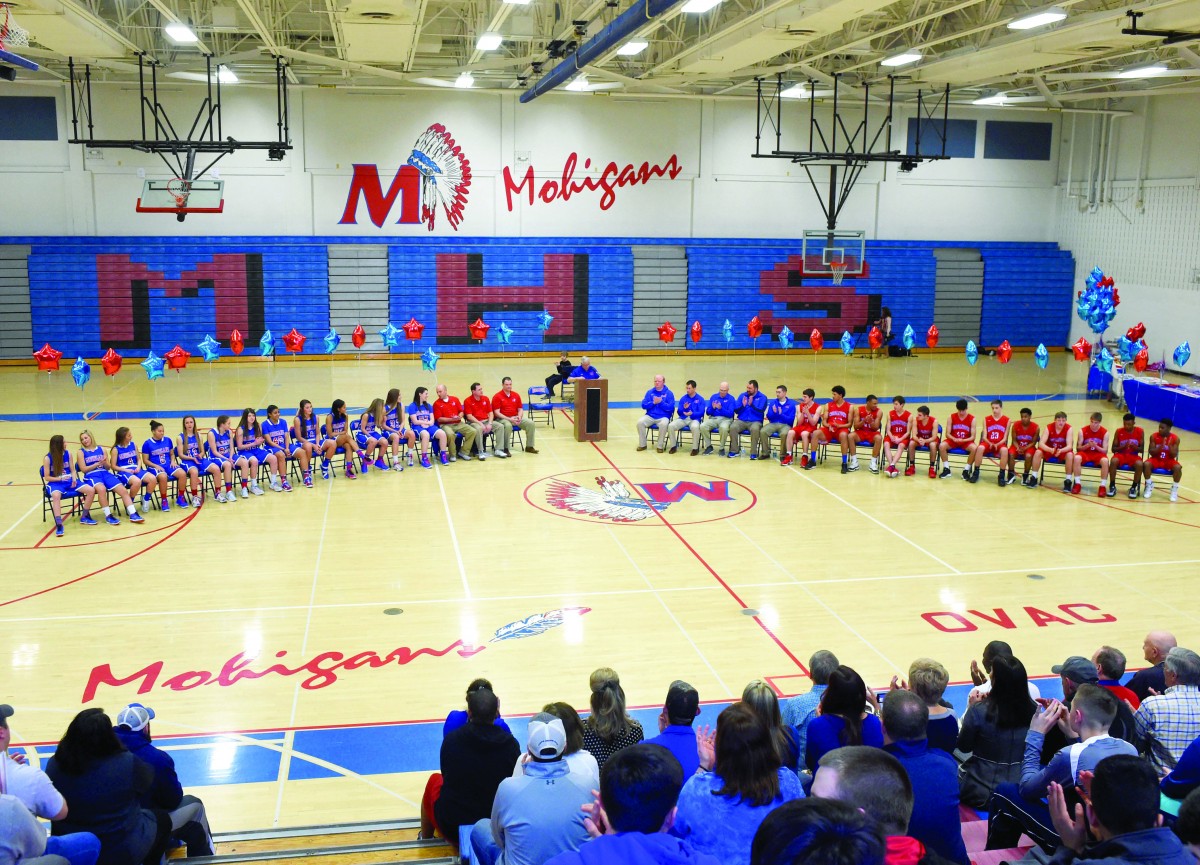MORGANTOWN — Rumor, school pride and social media converged to ruffle a few feathers recently when some Morgantown High alumni feared the school was discarding the Native American theme of is sports teams.
It concerned the Mohigans’ signature logo: A stylized “M” with a Native American headdress draped over one side.
The logo isn’t going away any time soon, athletics director John Bowers said.
Some people, though, feared the school was bowing to charges of insensitivity, after word spread the headdress logo was being sanded off the center of the basketball court — for a makeover, as it turns out.
“No, we’re not losing the headdress or any other traditions,” Bowers assured, after a number of MHS faithful posted protests on Facebook and social media.
The rumor morphed to include Morgantown High’s Red and Blue Marching Band, a nationally known assemblage that prominently features the head majorette in a headdress and other Indian-themed trappings in its performances.
“It’s business as usual for us,” said band director Keith Reed, who is also a graduate of the school.
MHS sports fans and band supporters insist the school isn’t insulting Native American culture, but rather honoring the history of a region that respects culture.
Double the logo
The headdress logo isn’t the only visual identification for the school, Bowers said.
A block “M” logo resides on the 50-yard-line of Pony Lewis Field, where the Mohigans play their home football games.
The new logo on the basketball court also will be a block “M,” in the middle of an outline of the state of West Virginia, Bowers said.
Both logos, the block M and the headdress M, will be interchangeable for marketing purposes.
Rooting for bigotry?
The debate over schools and pro franchises using Indian nicknames rolls on through the 21st century.
The Cleveland Indians of Major League Baseball took the moniker in 1915.
And the Washington Redskins of the NFL endured protests and legal challenges to trademark rights over its nickname and imagery.
Is the practice cultural respect — or licensed bigotry on a team jersey?
Kevin Gover told USA Today in 2016 that he’ll root for the latter every time. Gover, who directs
the Smithsonian Institution’s National Museum of the American Indian, is a citizen of the Pawnee Nation.
Some schools, such as the Seminoles of Florida State University, can tout their names with the blessings of local tribes.
Either way, Gover said, he sees it as war-paint caricature, hearkening back to the mass-cultural displacement of an indigenous people — even as fans and team members of such teams may not realize it.
“It’s like saying, ‘We, the white people won — and we can do anything with you and your culture and your imagery that we choose to do,’ ” he said in
that interview.
Wearing the identity
The headdress logo at Morgantown High doesn’t quite have the breadth of history, Bowers said, having been designed by a student only three decades ago.
“People want to say it’s been around forever, but it really only goes back to the ’90s,” Bowers said. “That’s what we can tell from looking back through yearbooks.”
In fact, it was a yearbook, and not Native American culture, that inspired the Mohigans moniker, according to school lore.
As chronicled in the MHS handbook for parents of student-athletes, the name Mohigan is a mash-up of the yearbook’s name “Morgantown High Annual.”
An identity was born by taking a bunched-up abbreviation — Mo-hi-gan — and the school kept
the Indian theme “to align with the well-known Mohican,” according to the handbook.
‘We need to be astute’
Today, MHS is among a handful of high schools across West Virginia still sporting Native American mascots, including the Bridgeport Indians, Parkersburg Big Reds and the Redskins of Hurricane High.
Bowers, who joined Morgantown High in 2004 and coached the Mohigans football team to consecutive perfect seasons and state titles, said he hasn’t heard any complaints or criticisms over the headdress logo or any other Indian themes used by the school.
Not yet, anyway.
“We need to be astute enough to realize that that day may come,” he said.




